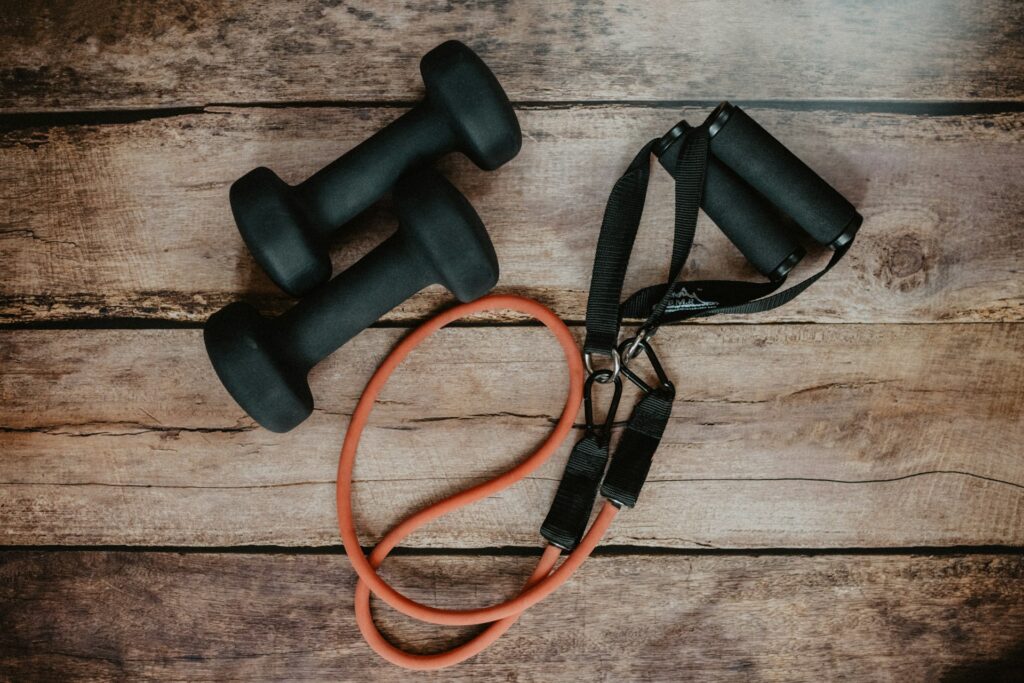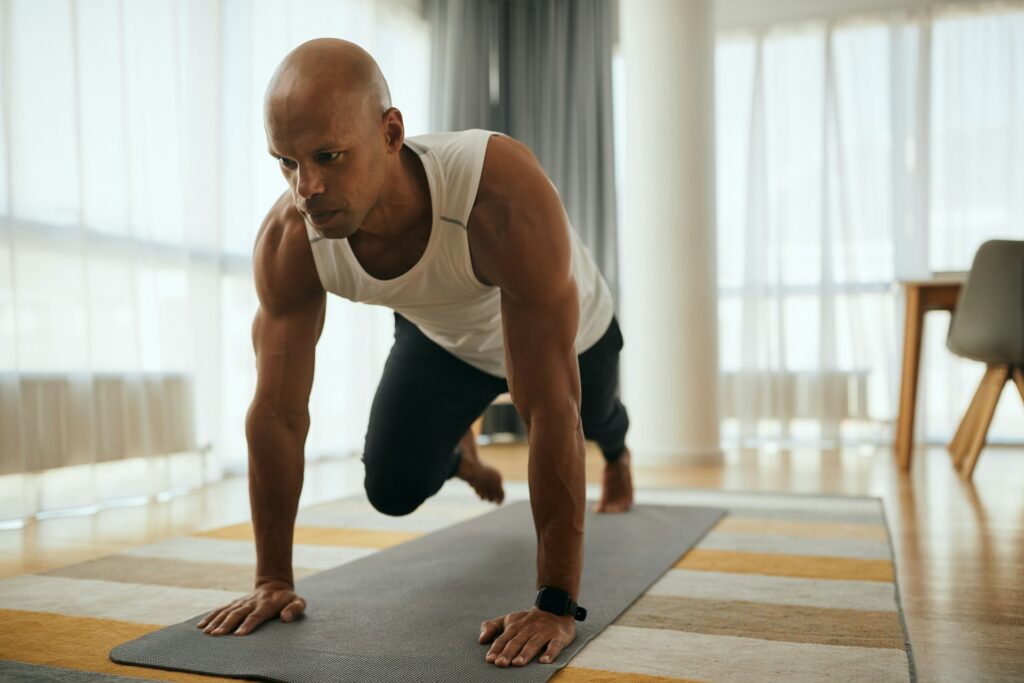Tips for Staying Fit Without a Gym: Getting Fit at Home
Working out at home can be a game-changer—no commute, no gym fees, and the ability to exercise on your own schedule. But just like any fitness routine, it comes with its own set of challenges, especially when it comes to motivation and consistency. Whether you’re in a small apartment or a home with extra space, creating an effective workout routine from your living room is totally possible.
This list of the best tips for working out at home is here to help you build a fitness routine that’s both effective and enjoyable. With a few smart strategies, you can turn any space into a workout zone and reach your goals without ever stepping into a gym.
And if you’re looking to level up your space, be sure to check out our list of the best home exercise equipment and the best resistance bands. These tools can help you maximize results and make home workouts even more engaging.
The Top 14 Tips for Working Out at Home
1. Designate a Workout Space
Creating a designated space in your home for workouts helps cue your brain to get into exercise mode. It doesn’t need to be a full room—a corner with a yoga mat, resistance bands, and a set of dumbbells can work just fine. When your workout area is easy to access and already set up, you’re more likely to follow through with your exercise plans. Keeping your gear organized and visible also acts as a reminder that movement is part of your routine. Even in small spaces, a defined zone can boost consistency and motivation.
2. Set a Realistic Workout Schedule
A major benefit of working out at home is flexibility, but that same flexibility can make it easier to skip sessions. Treat your workouts like important appointments by adding them to your calendar and setting reminders. Whether you prefer morning routines or evening sessions, establishing a consistent time builds discipline and turns movement into habit. Over time, the routine becomes second nature. Having a schedule also helps you track frequency and stay accountable.
3. Use Bodyweight Exercises
Bodyweight workouts are a highly effective way to build strength, improve endurance, and enhance mobility—no equipment required. Moves like push-ups, squats, planks, and burpees engage multiple muscle groups and can be adapted for any fitness level. They’re ideal for small spaces and require minimal setup, making them perfect for busy days. The key is to focus on good form and progression over time. Consistent bodyweight training can deliver impressive results with no gym needed.

4. Invest in a Few Key Pieces of Equipment
While not mandatory, adding a few versatile tools can elevate your at-home fitness experience. Resistance bands, dumbbells, kettlebells, and stability balls are affordable and take up little space. These items allow for greater variety and progression in your workouts, which helps prevent plateaus and keeps things interesting. You don’t need to build a full gym—just a few pieces can significantly expand your exercise options. Look for items that suit your specific goals and space.
5. Follow Online Workout Videos
One of the greatest resources for home fitness is the abundance of free and affordable workout videos online. Platforms like YouTube and fitness apps offer everything from beginner routines to advanced strength programs. Following a video can provide structure, guidance, and motivation—especially if you’re not sure where to start. It’s also a great way to try different styles, like HIIT, yoga, barre, or Pilates, to see what resonates with you. The visual instruction can improve form and boost engagement.
6. Minimize Distractions
Home environments come with their own set of interruptions—TVs, phones, kids, and chores can all pull you away from your session. Make your workout time sacred by silencing notifications, informing others in your home, and choosing a low-traffic area if possible. Using headphones with motivating music can help you stay in the zone. When you treat your workout time as non-negotiable, you’re more likely to finish strong. Creating boundaries around exercise helps you build consistency.

7. Set Small, Measurable Goals
Instead of vague intentions like “get in shape,” create goals that are specific, trackable, and realistic. For example, aim to complete four workouts this week or hold a plank for 60 seconds. Small wins build momentum and make larger goals feel more achievable. They also provide a sense of accomplishment that boosts confidence. Keep your goals visible and review them regularly to stay focused and motivated.
8. Use Music or Podcasts to Stay Engaged
The right soundtrack can completely transform your workout energy. Build a playlist with upbeat tracks that match your workout tempo or explore new music to keep things fresh. Alternatively, tuning into a podcast or audiobook can make steady-state cardio more enjoyable. This kind of entertainment helps the time pass faster and gives you something to look forward to. Whether you prefer high-energy music or calming background sounds, audio can enhance your performance and focus.
9. Mix It Up to Avoid Boredom
Doing the same workout repeatedly can lead to burnout and reduced results. To keep things interesting, try different formats, exercises, or even rearrange your workout schedule. Incorporating new moves challenges your muscles and keeps your mind engaged. You might try dance workouts one week, circuit training the next, and yoga the week after. Variety not only prevents boredom but also improves overall fitness by targeting different muscle groups and movement patterns.
10. Track Your Progress Over Time
Keeping a workout log, using a fitness app, or simply jotting notes in a journal helps you visualize your progress. Whether it’s tracking strength gains, flexibility, or consistency, seeing improvements over time is a powerful motivator. When you feel stuck or unmotivated, looking back on where you started can reignite your drive. Plus, it allows you to tweak your routine based on what’s working and what isn’t. Progress doesn’t have to be dramatic—every step forward counts.

11. Incorporate Mobility and Flexibility Work
It’s easy to focus solely on cardio and strength, but mobility and flexibility are equally important for overall fitness and injury prevention. Incorporate stretching, yoga, or foam rolling into your weekly routine to improve range of motion and recovery. These sessions can be short and relaxing, yet incredibly effective. They’re especially helpful after long days sitting or working from home. Flexibility work enhances performance in other workouts and helps your body feel its best.
12. Create a Post-Workout Ritual
Having a routine that signals the end of a workout can help you wind down and build a habit loop. This could be a short stretching session, drinking a recovery shake, or simply taking a moment to log your workout. Rituals reinforce consistency by linking the behavior to a rewarding conclusion. Over time, your brain associates the post-workout ritual with success and accomplishment. It’s a simple way to create closure and motivation for next time.
13. Take Advantage of Breaks Throughout the Day
If long workouts feel overwhelming, break them into smaller chunks. Doing three 10-minute sessions spread throughout your day still adds up to 30 minutes of movement. This approach works especially well when working from home or caring for children. Use breaks to stretch, do bodyweight circuits, or go for a walk. These mini-workouts help boost metabolism, clear your mind, and keep you consistent when time is tight.

14. Be Patient and Celebrate Consistency
Results take time—especially with at-home workouts—but consistency will always lead to progress. Focus less on immediate transformation and more on the habit you’re building. Celebrate the fact that you showed up, finished a workout, or stuck with your plan for the week. Every session is a step forward, and those steps add up over time. Motivation may fluctuate, but consistency builds momentum and long-term results.
Frequently Asked Questions About Working Out at Home
Can I get results working out at home without equipment?
Yes, absolutely. Bodyweight exercises can be very effective when done consistently with proper form and intensity. Adding progression over time—such as more reps, variations, or shortened rest periods—will help you continue to see results.
How long should I work out at home to see results?
You can start seeing benefits with just 20–30 minutes of focused exercise a few times per week. Visible changes may take several weeks, but improvements in energy, mood, and strength often appear sooner. Consistency is more important than duration.
What should I do if I feel unmotivated at home?
Start with something small, like a 5-minute warm-up or a single set of an exercise. Often, beginning is the hardest part—once you get moving, motivation tends to follow. Having a workout buddy, playlist, or video to follow can also help boost engagement.
Is it necessary to follow a specific program?
Following a structured program can provide direction and help ensure balanced training, but it’s not required. If you prefer mixing things up, aim for variety across strength, cardio, and mobility to create a well-rounded routine.
How do I stay consistent without external accountability?
Build internal accountability by tracking your workouts, setting goals, and celebrating small wins. You can also join online fitness groups or challenges for community support. Most importantly, make your workouts enjoyable so they become something you want to do.
Editor’s Notes on Home Workouts
This article was created to help readers take full advantage of their home environment for effective fitness. With the right mindset and strategies, home workouts can be just as productive—if not more so—than traditional gym sessions. We curated these tips based on common challenges and proven solutions that real people use to stay active from home. Whether you’re short on time, space, or equipment, these suggestions are meant to empower and simplify your fitness journey.
For more support, be sure to explore our list of the best home workout equipment and best fitness apps. Having the right tools and guidance can help you stay consistent and make working out at home feel easy and fun.
Conclusion: Building an Effective Home Workout Routine
Working out at home puts the power of fitness right at your fingertips. No commute, no pressure—just you and your goals. By following the tips above, you can create a home workout plan that’s simple, effective, and sustainable. Whether you’re starting from scratch or just need a refresh, these strategies will help you build consistency, stay motivated, and see results over time.
Keep in mind that progress isn’t about being perfect—it’s about showing up. When you turn your living space into a place of movement and energy, there’s no limit to what you can achieve. Start small, stay focused, and let every session move you one step closer to your best self.


